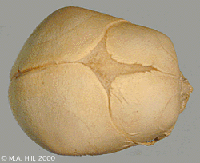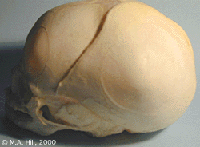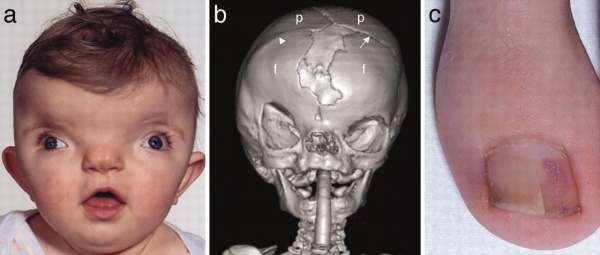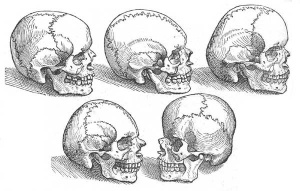Musculoskeletal System - Skull Development
Introduction
The Skull is a unique skeletal structure in several ways: embryonic cellular origin (neural crest), form of ossification (intramembranous and endochondrial) and flexibility (fibrous sutures). The cranial vault (which encloses the brain) bones are formed by intramembranous ossification. While the bones that form the base of the skull are formed by endochondrial ossification. The bones enclosing the brain have large flexible fibrous joints (sutures) which allow firstly the head to pass through the birth canal and secondly postnatal brain growth.
In humans, ossification continues postnatally, through puberty until mid 20s and in old age the sutures separating the vault plates are often completely ossified.
In the entire skeleton, early ossification occurs in the jaw and at the ends of long bones (More? see movie developing mouse). Osteoblasts manufacture bone and are derived from ectomesenchymal in origin. (More? see lineage below). Flexible fibrous sutures allow growth of the brain to be accomodated by calvarial plate growth. Recent studies have show that noggin (a BMP antagonist) is involved in closure of these sutures.
Some Recent Findings
- Epigenetic control of skull morphogenesis by histone deacetylase 8[1] "Histone deacetylases (Hdacs) are transcriptional repressors with crucial roles in mammalian development. Here we provide evidence that Hdac8 specifically controls patterning of the skull by repressing a subset of transcription factors in cranial neural crest cells. Global deletion of Hdac8 in mice leads to perinatal lethality due to skull instability, and this is phenocopied by conditional deletion of Hdac8 in cranial neural crest cells. Hdac8 specifically represses the aberrant expression of homeobox transcription factors such as Otx2 and Lhx1. These findings reveal how the identity and patterning of vertebrate-specific portions of the skull are epigenetically controlled by a histone deacetylase."
- Expression of five frizzleds during zebrafish craniofacial development.[2] "Wnt/Planar Cell Polarity (PCP) signaling is critical for proper animal development. ...Frizzled (Fzd) homologues are Wnt receptors ...Closer examination revealed that fzd7b is expressed in the neural crest and the mesodermal core of the pharyngeal arches and in the chondrocytes of newly stacked craniofacial cartilage elements. However, fzd7a is only expressed in the neural crest of the pharyngeal arches and fzd8a is expressed in the pharyngeal endoderm."
Skull Abnormalities - Craniosynostosis [3] "Craniosynostosis, the fusion of one or more of the sutures of the skull vault before the brain completes its growth, is a common (1 in 2,500 births) craniofacial abnormality, approximately 20% of which occurrences are caused by gain-of-function mutations in FGF receptors (FGFRs). ...These experiments show that attenuation of FGFR signaling by pharmacological intervention could be applied for the treatment of craniosynostosis or other severe bone disorders caused by mutations in FGFRs that currently have no treatment."
Skull Views

|

|

|
| anterior view | superior view | lateral view |
| showing anterior fontenelle, sutures, mandible | showing anterior fontenelle, sutures | showing suture, mandible |
Skull Sutures
The bones enclosing the brain have large flexible fibrous joints (sutures) which allow firstly the head to compress and pass through the birth canal and secondly to postnatally expand for brain growth. (More? Molecular Skull Sutures) These sutures gradually fuse at different times postnatally, firstly the metopic suture in infancy and the others much later. Abnormal fusion (synostosis) of any of the sutures will lead to a number of different skull defects. (More? Abnormal Synostosis) In old age all these sutures are generally completely fused and ossified.
coronal suture
lambdoid suture
metopic suture begins at nose and runs superiorly to meet sagittal suture and fuses during infancy (fusion beginning at 3 months and completes by 6 to 8 months of age) before all other cranial sutures.
sagittal suture
Abnormal Synostosis
There are several skull deformities caused by premature fusion (synostosis) of different developing skull sutures. Suture abnormalities are classified as either "simple" (only one suture involved) or "compound" (two or more sutures involved).
 |
* craniosynostosis premature cranial suture fusion, results in an abnormal skull shape, blindness and mental retardation.
|
Craniosynostosis
Attenuation of signaling pathways stimulated by pathologically activated FGF-receptor 2 mutants prevents craniosynostosis.[4] "Craniosynostosis, the fusion of one or more of the sutures of the skull vault before the brain completes its growth, is a common (1 in 2,500 births) craniofacial abnormality, approximately 20% of which occurrences are caused by gain-of-function mutations in FGF receptors (FGFRs). ...These experiments show that attenuation of FGFR signaling by pharmacological intervention could be applied for the treatment of craniosynostosis or other severe bone disorders caused by mutations in FGFRs that currently have no treatment."
Craniofrontonasal Syndrome
Craniofrontonasal syndrome (CFNS) is a human X-linked developmental disorder caused by a mutation in ephrin-B1 affecting mainly females. Characterised by abnormal development of cranial and nasal bones, craniosynostosis (premature coronal suture fusion), and other extracranial anomalies (limb polydactyly and syndactyly).

|
(a) Facial view showing marked hypertelorism, divergent squint, and central nasal groove (subject age, 1 year).
(b) Three-dimensional computed tomographic skull reconstruction (subject age, 8 months) showing right unicoronal synostosis, lateral displacement of orbits, and central defect between frontal bones. Note bony ridge at site of obliterated right coronal suture (arrowhead); the left coronal suture is patent (arrow). f, frontal bone; p, parietal bone. (c) Longitudinal splitting of the nails is frequent. |
| Craniofrontonasal syndrome[5] | Links: OMIM - Craniofrontonasal Syndrome |
Skull Bone Histology
A histological image of a skull bone.
Bone Cell Lineages
Molecular Development
Skull Sutures
The BMP antagonist noggin regulates cranial suture fusion STEPHEN M. WARREN, LISA J. BRUNET, RICHARD M. HARLAND, ARIS N.,ECONOMIDES & MICHAEL T. LONGAKER
"During skull development, the cranial connective tissue framework undergoes intramembranous ossification to form skull bones (calvaria). As the calvarial bones advance to envelop the brain, fibrous sutures form between the calvarial plates. Expansion of the brain is coupled with calvarial growth through a series of tissue interactions within the cranial suture complex. Craniosynostosis, or premature cranial suture fusion, results in an abnormal skull shape, blindness and mental retardation. Recent studies have demonstrated that gain-of-function mutations in fibroblast growth factor receptors ( fgfr ) are associated with syndromic forms of craniosynostosis. Noggin, an antagonist of bone morphogenetic proteins (BMPs), is required for embryonic neural tube, somites and skeleton patterning. Here we show that noggin is expressed postnatally in the suture mesenchyme of patent, but not fusing, cranial sutures, and that noggin expression is suppressed by FGF2 and syndromic fgfr signalling. Since noggin misexpression prevents cranial suture fusion in vitro and in vivo , we suggest that syndromic fgfr -mediated craniosynostoses may be the result of inappropriate downregulation of noggin expression."
References
Reviews
<pubmed>1522265</pubmed> <pubmed>9482048</pubmed> <pubmed>7813156</pubmed> <pubmed>7813157</pubmed> <pubmed>8266985</pubmed>
Articles
<pubmed>14504503</pubmed>
Search PubMed
Search July 2010 "Skull Development" All (15473) Review (1231) Free Full Text (1634)
Search Pubmed: Skull Development
Additional Images
Terms
Glossary Links
- Glossary: A | B | C | D | E | F | G | H | I | J | K | L | M | N | O | P | Q | R | S | T | U | V | W | X | Y | Z | Numbers | Symbols | Term Link
Cite this page: Hill, M.A. (2024, May 2) Embryology Musculoskeletal System - Skull Development. Retrieved from https://embryology.med.unsw.edu.au/embryology/index.php/Musculoskeletal_System_-_Skull_Development
- © Dr Mark Hill 2024, UNSW Embryology ISBN: 978 0 7334 2609 4 - UNSW CRICOS Provider Code No. 00098G





